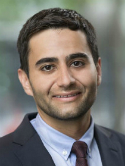Neoadjuvant PD-1 and PD-L1 blockade with chemotherapy for borderline resectable and unresectable Stage III non-small cell lung cancer Journal Article
| Authors: | Ricciuti, B.; Fusco, F.; Cooper, A.; Garbo, E.; Pecci, F.; Aldea, M.; Wang, X.; Mayoral Penalva, M.; Ginsberg, M.; Sholl, L. M.; Nishino, M.; Di Federico, A.; Shaverdian, N.; Bott, M.; Santo, V.; Rendina, E.; Trisolini, R.; Ramella, S.; Gallina, F.; Melis, E.; Buglioni, S.; Minuti, G.; Landi, L.; Ugalde Figueroa, P. A.; Shaw, A. T.; Chaft, J.; Awad, M. M.; Cappuzzo, F. |
| Article Title: | Neoadjuvant PD-1 and PD-L1 blockade with chemotherapy for borderline resectable and unresectable Stage III non-small cell lung cancer |
| Abstract: | Importance: Patients with borderline resectable or unresectable stage III non-small cell lung cancer (NSCLC) with T4 and/or N2-N3 involvement face limited treatment options and poor outcomes. Neoadjuvant chemoimmunotherapy has shown promise in improving resectability and pathological responses. Objective: To evaluate the efficacy of neoadjuvant programmed cell death 1 protein (PD-1) or programmed cell death 1 ligand 1 (PD-L1) blockade combined with chemotherapy in enhancing surgical outcomes and pathological responses in patients with T4 and/or N2-N3 stage III NSCLC. Design, Setting, and Participants: This multicenter cohort study analyzed data from patients treated between February 2018 and January 2024 with neoadjuvant PD-1/PD-L1 inhibitors plus chemotherapy at academic and tertiary care centers across the US and Italy. Pathological and survival outcomes were assessed. Patients with stage III NSCLC and T4 and/or N2-N3 involvement were included. Data were collected from February 2018 to January 2024. Exposures: Neoadjuvant PD-1/PD-L1 blockade combined with platinum-based chemotherapy. Main Outcomes and Measures: Pathological complete response (pCR), major pathological response, surgical resectability, and event-free survival (EFS). Results: Of 112 patients, 58 (51.8%) were female, and the median (range) age was 66 (41-84) years. A total of 84(75.0%) underwent surgical resection, achieving a pCR rate of 29.0% (24 of 83 with available final pathology) and a major pathological response rate of 42.2% (35 of 83). Patients with both PD-L1 expression of 50% or more and high tumor mutational burden achieved the highest pCR rate (4 of 9 [44.4%]; P =.03). Conversely, covariants in KRAS/STK11 or KRAS/KEAP1 were associated with lack of pCR. Patients with single-station or multistation N2/N3 disease exhibited comparable pathological outcomes. The median EFS for all resected patients was 52.6 months (95% CI, 27.8 to not reached), and this was significantly longer in patients with pCR (not reached vs 27.8 months [95% CI, 19.5 to not reached]; P <.001). Conclusions and Relevance: In this study, neoadjuvant PD-1/PD-L1 blockade combined with chemotherapy resulted in high pathological response rates and surgical resectability in patients with T4 and/or N2-N3 stage III NSCLC. This approach offers a viable treatment option for patients with borderline resectable or unresectable NSCLC but requires further validation through prospective studies.. © 2025 American Medical Association. All rights reserved. |
| Journal Title: | JAMA Oncology |
| Volume: | 11 |
| Issue: | 7 |
| ISSN: | 2374-2437 |
| Publisher: | American Medical Association |
| Publication status: | Published |
| Date Published: | 2025-07-01 |
| Start Page: | 735 |
| End Page: | 741 |
| Language: | English |
| DOI: | 10.1001/jamaoncol.2025.1115 |
| PUBMED: | 40402502 |
| PROVIDER: | scopus |
| PMCID: | PMC12100510 |
| DOI/URL: | |
| Notes: | Source: Scopus |
Altmetric
Citation Impact
BMJ Impact Analytics
MSK Authors
-
 239
239Ginsberg -
 293
293Chaft -
 139
139Bott -
 100
100Shaverdian -
 18
18Cooper
Related MSK Work




